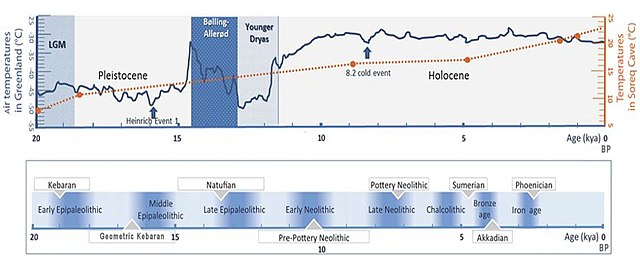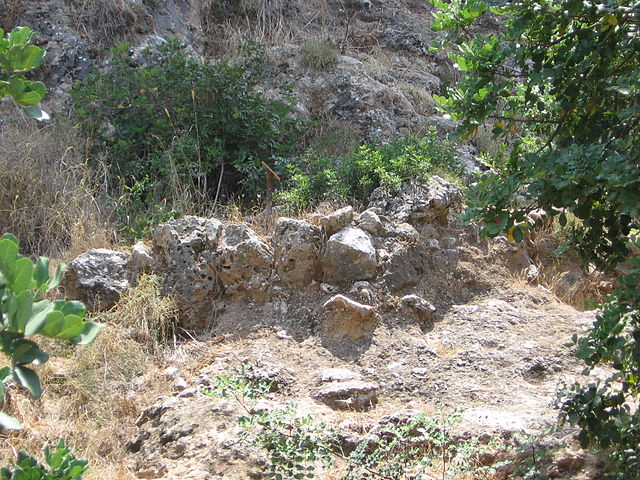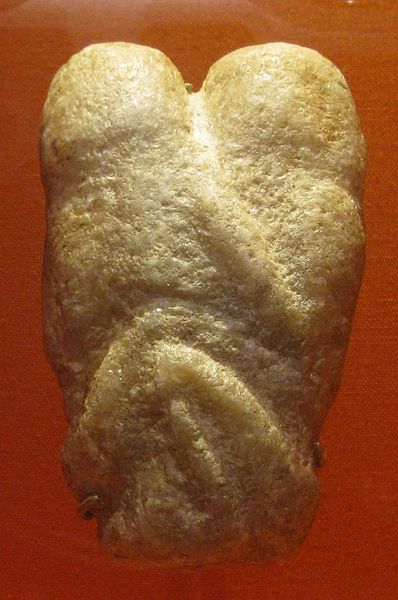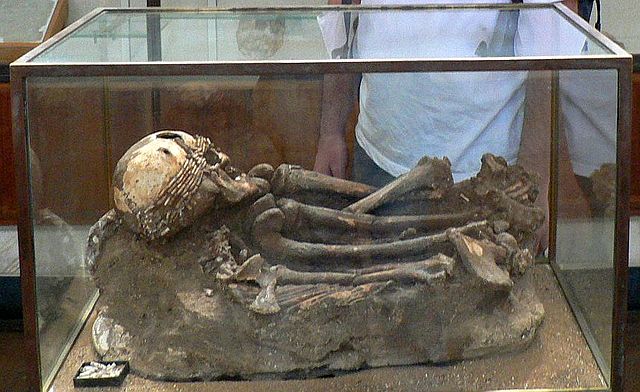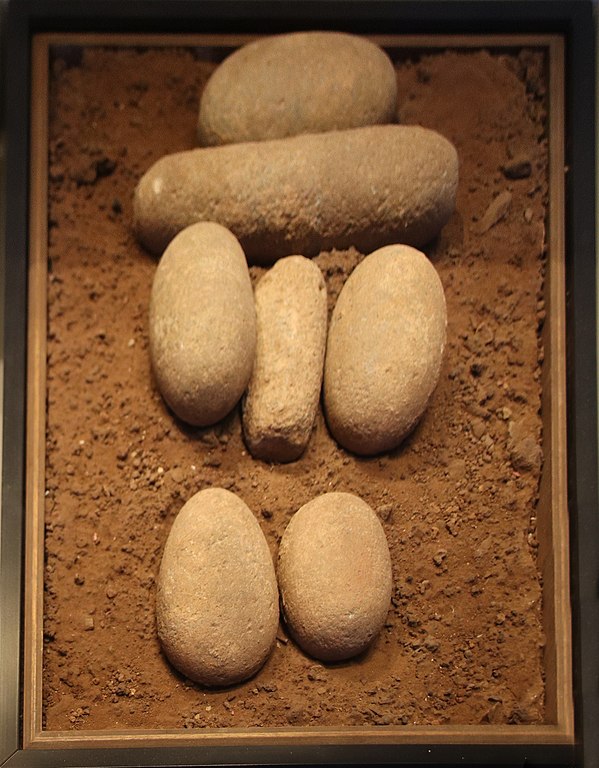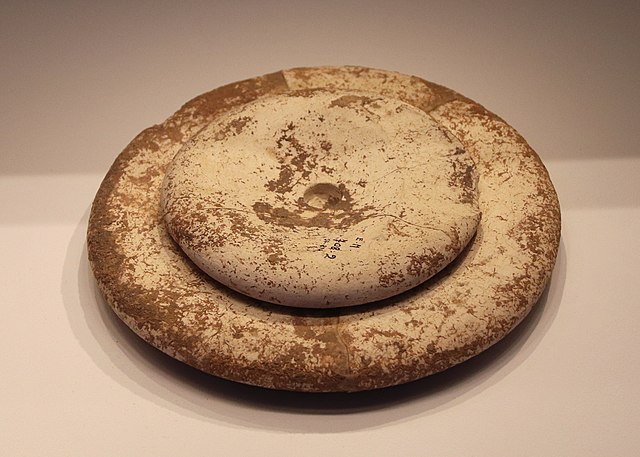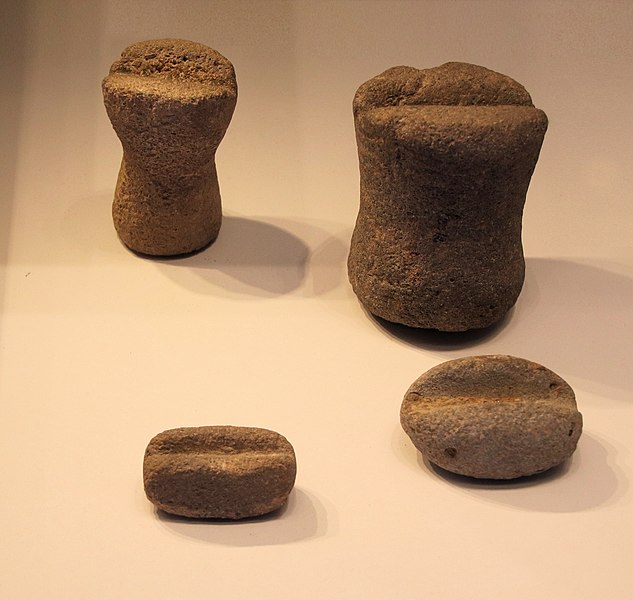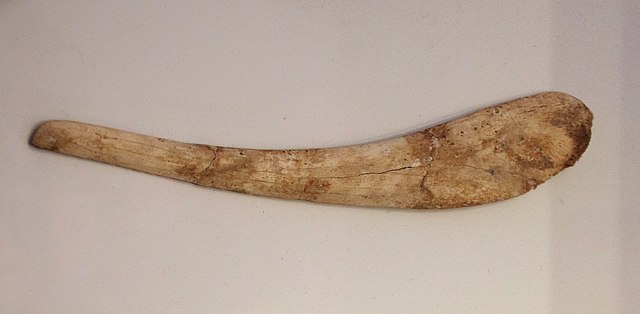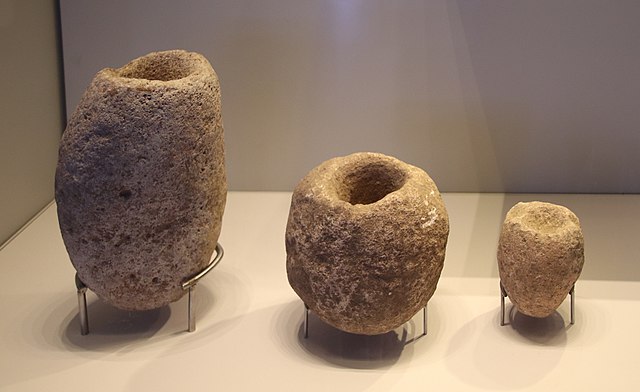
| NATUFIAN CULTURE
Natufian culture Geographical
range : Levant
The Natufian culture is a Late Epipaleolithic archaeological culture of the Levant, dating to around 15,000 to 11,500 years ago. The culture was unusual in that it supported a sedentary or semi-sedentary population even before the introduction of agriculture. The Natufian communities may be the ancestors of the builders of the first Neolithic settlements of the region, which may have been the earliest in the world. Natufians founded a settlement where Jericho is today, which may therefore be the longest continuously inhabited urban area on Earth. Some evidence suggests deliberate cultivation of cereals, specifically rye, by the Natufian culture, at Tell Abu Hureyra, the site of earliest evidence of agriculture in the world. The world's oldest evidence of bread-making has been found at Shubayqa 1, a 14,500-year-old site in Jordan's northeastern desert. In addition, the oldest known evidence of beer, dating to approximately 13,000 BP, was found at the Raqefet Cave in Mount Carmel near Haifa in Israel.
Generally, though, Natufians exploited wild cereals. Animals hunted included gazelles. According to Christy G. Turner II, there is archaeological and physical anthropological evidence for a relationship between the modern Semitic-speaking populations of the Levant and the Natufians. Archaeogenetics have revealed derivation of later (Neolithic to Bronze Age) Levantines primarily from Natufians, besides substantial admixture from Chalcholithic Anatolians.
Dorothy Garrod coined the term Natufian based on her excavations at Shuqba cave (Wadi an-Natuf) in the western Judean Mountains (located in Isreal).
Discovery :
Dorothy Garrod (centre) discovered the Natufian culture in 1928 The Natufian culture was discovered by British archaeologist Dorothy Garrod during her excavations of Shuqba cave in the Judaean Hills in the West Bank of the Jordan River. Prior to the 1930s, the majority of archaeological work taking place in British Palestine was biblical archaeology focused on historic periods, and little was known about the region's prehistory. In 1928, Garrod was invited by the British School of Archaeology in Jerusalem (BSAJ) to excavate Shuqba cave, where prehistoric stone tools had been discovered by a French priest named Alexis Mallon four years earlier. She discovered a layer sandwiched between the Upper Palaeolithic and Bronze Age deposits characterised by the presence of microliths. She identified this with the Mesolithic, a transitional period between the Palaeolithic and the Neolithic which was well-represented in Europe but had not yet been found in the Near East. A year later, when she discovered similar material at el-Wad Terrace, Garrod suggested the name "the Natufian culture", after Wadi an-Natuf that ran close to Shuqba. Over the next two decades Garrod found Natufian material at several of her pioneering excavations in the Mount Carmel region, including el-Wad, Kebara and Tabun, as did the French archaeologist René Neuville, firmly establishing the Natufian culture in the regional prehistoric chronology. As early as 1931, both Garrod and Neuville drew attention to the presence of stone sickles in Natufian assemblages and the possibility that this represented a very early agriculture.
Dating :
The
Natufian appeared at the time of the Bølling-Allerød
warming, before temperatures dropped drastically again during the
Younger Dryas. Temperatures would rise again at the end of the Younger
Dryas, and with the onset of the Holocene and the Neolithic Revolution.
Climate and Post-Glacial expansion in the Near East, based on the
analysis of Greenland ice cores.
The period is commonly split into two subperiods: Early Natufian (12,000–10,800 BC) and Late Natufian (10,800–9,500 BC). The Late Natufian most likely occurred in tandem with the Younger Dryas (10,800 to 9,500 BC). The Levant hosts more than a hundred kinds of cereals, fruits, nuts, and other edible parts of plants, and the flora of the Levant during the Natufian period was not the dry, barren, and thorny landscape of today, but rather woodland.
Precursors
and associated cultures :
More generally there has been discussion of the similarities of these cultures with those found in coastal North Africa. Graeme Barker notes there are: "similarities in the respective archaeological records of the Natufian culture of the Levant and of contemporary foragers in coastal North Africa across the late Pleistocene and early Holocene boundary". According to Isabelle De Groote and Louise Humphrey Natufians practiced the Iberomaurusian and Capsian custom of sometimes extracting their maxillary central incisors (upper front teeth).
Mortars from Natufian Culture, grinding stones from Neolithic pre-pottery phase (Dagon Museum) Ofer Bar-Yosef has argued that there are signs of influences coming from North Africa to the Levant, citing the microburin technique and "microlithic forms such as arched backed bladelets and La Mouillah points." But recent research has shown that the presence of arched backed bladelets, La Mouillah points, and the use of the microburin technique was already apparent in the Nebekian industry of the Eastern Levant. And Maher et al. state that, "Many technological nuances that have often been always highlighted as significant during the Natufian were already present during the Early and Middle EP [Epipalaeolithic] and do not, in most cases, represent a radical departure in knowledge, tradition, or behavior."
Authors such as Christopher Ehret have built upon the little evidence available to develop scenarios of intensive usage of plants having built up first in North Africa, as a precursor to the development of true farming in the Fertile Crescent, but such suggestions are considered highly speculative until more North African archaeological evidence can be gathered. In fact, Weiss et al. have shown that the earliest known intensive usage of plants was in the Levant 23,000 years ago at the Ohalo II site.
Anthropologist C. Loring Brace (1993) cross-analysed the craniometric traits of Natufian specimens with those of various ancient and modern groups from the Near East, Africa and Europe. The Late Pleistocene Epipalaeolithic Natufian sample was described as problematic due to its small size (consisting of only three males and one female), as well as the lack of a comparative sample from the Natufians' putative descendants in the Neolithic Near East. Brace observed that the Natufian fossils lay between those of the Niger-Congo-speaking populations and the other samples, which he suggested may point to a Sub-Saharan influence in their constitution. Subsequent ancient DNA analysis of Natufian skeletal remains by Lazaridis et al. (2016) found that the specimens instead were a mix of 50% Basal Eurasian ancestral component (see genetics) and 50% Western Eurasian Unknown Hunter Gatherer (UHG) population related to European Western Hunter-Gatherers.
According to Bar-Yosef and Belfer-Cohen, "It seems that certain preadaptive traits, developed already by the Kebaran and Geometric Kebaran populations within the Mediterranean park forest, played an important role in the emergence of the new socioeconomic system known as the Natufian culture."
Settlements :
Epipalaeolithic Near East temporary tents (Sanliurfa Museum) Settlements occur in the woodland belt where oak and Pistacia species dominated. The underbrush of this open woodland was grass with high frequencies of grain. The high mountains of Lebanon and the Anti-Lebanon, the steppe areas of the Negev desert in Israel and Sinai, and the Syro-Arabian desert in the east were much less favoured for Natufian settlement, presumably due to both their lower carrying capacity and the company of other groups of foragers who exploited this region.
Remains of a wall of a Natufian house The habitations of the Natufian were semi-subterranean, often with a dry-stone foundation. The superstructure was probably made of brushwood. No traces of mudbrick have been found, which became common in the following Pre-Pottery Neolithic A (PPNA). The round houses have a diameter between three and six meters, and they contain a central round or subrectangular fireplace. In Ain Mallaha traces of postholes have been identified. Villages can cover over 1,000 square meters. Smaller settlements have been interpreted by some researchers as camps. Traces of rebuilding in almost all excavated settlements seem to point to a frequent relocation, indicating a temporary abandonment of the settlement. Settlements have been estimated to house 100–150 people, but there are three categories: small, medium, and large, ranging from 15 sq. m to 1,000 sq. m. There are no definite indications of storage facilities.
Material culture :
The
Ain Sakhri lovers, from Ain Sakhri, near Bethleem (British Museum:
1958,1007.1 )
Sickle blades also appear for the first time in the Natufian lithic industry. The characteristic sickle-gloss shows that they were used to cut the silica-rich stems of cereals, indirectly suggesting the existence of incipient agriculture. Shaft straighteners made of ground stone indicate the practice of archery. There are heavy ground-stone bowl mortars as well.
Art
:
Burials :
Natufian burial – Homo 25 from el-Wad Cave, Mount Carmel, Israel (Rockefeller Museum) Natufian grave goods are typically made of shell, teeth (of red deer), bones, and stone. There are pendants, bracelets, necklaces, earrings, and belt-ornaments as well.
Schematic human figure made of pebbles, from Eynan, Early Natufian, 12,000 BC In 2008, the 12,400–12,000 cal BC grave of an apparently significant Natufian female was discovered in a ceremonial pit in the Hilazon Tachtit cave in northern Israel. Media reports referred to this person as a shaman. The burial contained the remains of at least three aurochs and 86 tortoises, all of which are thought to have been brought to the site during a funeral feast. The body was surrounded by tortoise shells, the pelvis of a leopard, forearm of a wild boar, wingtip of a golden eagle, and skull of a stone marten.
Long-distance
exchange :
Other
finds :
In 2018, the world's oldest brewery was found, with the residue of 13,000-year-old beer, in a prehistoric cave near Haifa in Israel when researchers were looking for clues into what plant foods the Natufian people were eating. This is 8,000 years earlier than experts previously thought beer was invented.
A study published in 2019 shows an advanced knowledge of lime plaster production at a Natufian cemetery in Nahal Ein Gev II site in the Upper Jordan Valley dated to 12 thousand (calibrated) years before present [k cal BP]. Production of plaster of this quality was previously thought to have been achieved some 2,000 years later.
Subsistence :
Mortar and pestle from Nahal Oren, Natufian, 12,500 – 9500 BC
Grinding tool from Gilgal, Natufian culture, 12,500 – 9500 BC
Basalt sharpening stones, Eynan and Nahal Oren, Natufian Culture, 12,500 – 9500 BC The Natufian people lived by hunting and gathering. The preservation of plant remains is poor because of the soil conditions, but wild cereals, legumes, almonds, acorns and pistachios may have been collected. Animal bones show that gazelle (Gazella gazella and Gazella subgutturosa) were the main prey. Additionally deer, aurochs and wild boar were hunted in the steppe zone, as well as onagers and caprids (ibex). Water fowl and freshwater fish formed part of the diet in the Jordan River valley. Animal bones from Salibiya I (12,300 – 10,800 cal BP) have been interpreted as evidence for communal hunts with nets, however, the radiocarbon dates are far too old compared to the cultural remains of this settlement, indicating contamination of the samples.
Development
of agriculture
According to one theory, it was a sudden change in climate, the Younger Dryas event (c. 10,800 to 9500 BC), which inspired the development of agriculture. The Younger Dryas was a 1,000-year-long interruption in the higher temperatures prevailing since the Last Glacial Maximum, which produced a sudden drought in the Levant. This would have endangered the wild cereals, which could no longer compete with dryland scrub, but upon which the population had become dependent to sustain a relatively large sedentary population. By artificially clearing scrub and planting seeds obtained from elsewhere, they began to practice agriculture. However, this theory of the origin of agriculture is controversial in the scientific community.
Bovine-rib dagger, HaYonim Cave, Natufian Culture, 12,500 – 9500 BC
Stone mortars from Eynan, Natufian period, 12,500 – 9500 BC
Stone mortar from Eynan, Natufian period, 12,500 – 9500 BC Domesticated
dog :
Woman's pelvis decorated with fox teeth, Hayonim Cave, Natufian Culture, 12,500–9500 BC According to ancient DNA analyses conducted by Lazaridis et al. (2016) on Natufian skeletal remains from present-day northern Israel, the Natufians carried the Y-DNA (paternal) haplogroups E1b1b1b2(xE1b1b1b2a,E1b1b1b2b) (2/5; 40%), CT (2/5; 40%), and E1b1(xE1b1a1,E1b1b1b1) (1/5; 20%). In terms of autosomal DNA, these Natufians carried around 50% of the Basal Eurasian (BE) and 50% of Western Eurasian Unknown Hunter Gatherer (UHG) components. However, they were slightly distinct from the northern Anatolian populations that contributed to the peopling of Europe, who had higher Western Hunter Gatherer (WHG) inferred ancestry.
Natufians were strongly genetically differentiated from Neolithic Iranian farmers from the Zagros Mountains, who were a mix of Basal Eurasians (up to 62%) and Ancient North Eurasians (ANE). This might suggest that different strains of Basal Eurasians contributed to Natufians and Zagros farmers, as both Natufians and Zagros farmers descended from different populations of local hunter gatherers. Contact between Natufians, other Neolithic Levantines, Caucasus Hunter Gatherers (CHG), Anatolian and Iranian farmers is believed to have decreased genetic variability among later populations in the Middle East. The scientists suggest that the Levantine early farmers may have spread southward into East Africa, bringing along Western Eurasian and Basal Eurasian ancestral components separate from that which would arrive later in North Africa. According to their results, the Natufians shared no genetic affinity to present-day sub-Saharan Africans. However the scientists state that they were unable to test for affinity in the Natufians to early North African populations using present-day North Africans as a reference because present-day North Africans owe most of their ancestry to back-migration from Eurasia.
Ancient DNA analysis has confirmed ancestral ties between the Natufian culture bearers and the makers of the Epipaleolithic Iberomaurusian culture of the Maghreb, the Pre-Pottery Neolithic culture of the Levant, the Early Neolithic Ifri n'Amr or Moussa culture of the Maghreb, the Savanna Pastoral Neolithic culture of East Africa, the Late Neolithic Kelif el Boroud culture of the Maghreb, and the Ancient Egyptian culture of the Nile Valley, with fossils associated with these early cultures all sharing a common genomic component. A 2018 analysis of autosomal DNA using modern populations as a reference, found The Natufian sample consisted of 61.2% Arabian, 21.2% Northern African, 10.9% Western Asian, and 6.8% Omotic-related ancestry (related to the Omotic peoples of southern Ethiopia). It is suggested that this (6.8%) Omotic component may have been associated with the spread of Y-haplogroup E (particularly Y-haplogroup E-M215, also known as "E1b1b") lineages to Western Eurasia.
Language :
Limestone and basalt mortars, Eynan, Early Natufian, circa 12,000 BC While the period involved makes it difficult to speculate on any language associated with the Natufian culture, linguists who believe it is possible to speculate this far back in time have written on this subject. As with other Natufian subjects, opinions tend to either emphasize North African connections or Asian connections. The view that the Natufians spoke an Afroasiatic language is accepted by Vitaly Shevoroshkin. Alexander Militarev and others have argued that the Natufian may represent the culture that spoke the proto-Afroasiatic language, which he in turn believes has a Eurasian origin associated with the concept of Nostratic languages. The possibility of Natufians speaking proto-Afro-Asiatic, and that the language was introduced into Africa from the Levant, is approved by Colin Renfrew with caution, as a possible hypothesis for proto-Afro-Asiatic dispersal.
Some scholars, for example Christopher Ehret, Roger Blench and others, contend that the Afroasiatic Urheimat is to be found in North Africa or Northeast Africa, probably in the area of Egypt, the Sahara, Horn of Africa or Sudan. Within this group, Ehret, who like Militarev believes Afroasiatic may already have been in existence in the Natufian period, would associate Natufians only with the Near Eastern pre-proto-Semitic branch of Afroasiatic.
Sites
:
•
Aammiq 2
•
Nachcharini Cave
Source :
https://en.wikipedia.org |

_1928_Natufian_culture_discovery.jpg)
